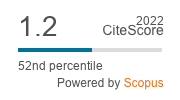Conductas sexuales de riesgo en la era digital: análisis del fenómeno sexting en la población adulta joven española
Resumen
Resumen
Los programas preventivos sobre conductas de riesgo a través de las tecnologías se dirigen fundamentalmente a menores de edad, pero escasamente se centran en la población mayor de edad. Para promover este nuevo enfoque es preciso investigar el comportamiento de adultos ante las tecnologías, especialmente cuando tales conductas pueden derivar en una exposición pública no deseada de la intimidad de la persona. Por ello, el objetivo de este trabajo es estudiar el fenómeno del sexting o intercambio de contenidos erótico-sexuales a través de medios electrónicos en una muestra de 171 adultos españoles, comparando los resultados según dos grupos de edad (18 – 26 años y 27 – 38 años). Se llevó a cabo un estudio asociativo-correlacional mediante cuestionario online. Los principales resultados muestran una alta participación en sexting, tanto en el caso del envío (sexting activo) como de la recepción de contenidos sexuales (sexting pasivo). Un mayor número de hombres que de mujeres envían online imágenes propias de índole sexual, siendo también los hombres los que reciben con mayor asiduidad este tipo de imágenes. Los participantes menores de 26 años se involucran con más frecuencia que los mayores de 26 años en sexting activo y sexting pasivo. Asimismo, se realiza sexting con diferentes perfiles de personas, aunque fundamentalmente con la pareja, destacándose entre las motivaciones más frecuentes la intención de satisfacer. Se discute la necesidad de profundizar en el estudio del sexting en adultos y de considerar los riesgos potenciales de esta práctica ante una difusión no consentida de las imágenes erótico-sexuales.
Abstract
Prevention programs on risk behaviors through technologies are aimed primarily at children, but rarely focus on the older population. To promote this new approach, it is necessary to investigate the behavior of adults with technologies, especially when these behaviors can lead to unwanted public exposure of the individual privacy. Thus, the aim of this paper is to study the phenomenon of sexting or exchange of erotic-sexual contents through electronic means in a sample of 171 Spanish adults, comparing the results according to two age groups (18 - 26 years and 27 - 38 years). An associative-correlational study was carried out using an online questionnaire. The main results show that a greater number of men than women send their own sexual images online, being also men who receive this type of images more frequently. Participants younger than 26 are more involved than participants older than 26 in active sexting and passive sexting. Likewise, sexting is carried out with different profiles of people, although fundamentally with the partner, standing out among the most frequent motivations the intention to satisfy. The need to deepen the study of sexting in adults and to consider the potential risks of this practice in a non-consensual diffusion of erotic-sexual images is discussed.
Palabras clave: sexting, adultos, género, tecnologías, comportamientos sexuales / sexting, adults, gender, technologies, sexual behaviors.
Descargas
Citas
Alonso-Ruido, P., Rodríguez-Castro, Y., Pérez-André, C., y José-Magalhães, M. J. 2015. “Estudio cualitativo en un grupo de estudiantes ourensanos/as sobre el fenómeno del sexting”. Revista de Estudios e Investigación en Psicología y Educación, 2014(14): 10–14. https://doi.org/10.17979/reipe.2015.0.
Benotsch, E., Snipes, D., Martin, A., y Bull, S. 2013. “Sexting, substance use, and sexual risk behavior in young adults”. Journal of Adolescent Health, 52(3): 307–313. https://doi.org/10.1016/j.jadohealth.2012.06.011
Cornejo, M., y Tapia, M. L. 2011. “Redes sociales y relaciones interpersonales en internet”. Fundamentos en Humanidades, 12 (24): 219-229.
Cruz, L., y Soriano, E. 2014. “Psychological aspects, attitudes and behaviour related to the practice of sexting: a systematic review of the existent literature”. Procedia - Social and Behavioral Sciences, 132(132), 114–120. doi: https://doi.org/10.1016/j.sbspro.2014.04.286
Dake, J. A., Price, D. H., Maziarz, L., y Ward, B. 2012. “Prevalence and correlates of sexting behaviour in adolescents”. American Journal of Sexuality Education, 7: 1–15. https://doi.org/10.1080/15546128.2012.650959
Delevi, R., y Weisskirch, R. S. 2013. “Personality factors as predictors of sexting”. Computers in Human Behavior, 29(6): 2589–2594. https://doi.org/10.1016/j.chb.2013.06.003
Drouin, M., Coupe, M., y Temple, J. R. 2017. “Is sexting good for your relationship? It depends…” Computers in Human Behavior, 75: 749–756. https://doi.org/10.1016/j.chb.2017.06.018
Drouin, M., Ross, J., y Tobin, E. 2015. “Sexting: A new, digital vehicle for intimate partner aggression?” Computers In Human Behavior, 50: 197-204. http://dx.doi.org/10.1016/j.chb.2015.04.001
Drouin, M., Vogel, K. N., Surbey, A., y Stills, J. R. 2013. “Let’s talk about sexting, baby: Computer-mediated sexual behaviors among young adults”. Computers in Human Behavior, 29(5): A25–A30. https://doi.org/10.1016/j.chb.2012.12.030
Durán, M. y Rodríguez-Domínguez, C. 2017. “Nuevos tiempos, nuevos peligros: intercambio de contenidos sexuales entre adolescentes en la era digital”. Comunicación presentada en el Congreso Internacional sobre Participación, Políticas Sociales y Protección de la Infancia. 16-30 octubre. Huelva, España.
Englander, E. 2012. Low risk associated with most teenage sexting: A study of 617 18- year-olds. Massachusetts Aggression Reduction Center. Consulta 5 de marzo 2018 (https://goo.gl/mAQ4B3)
Fajardo, M. I., Gordillo, M., y Regalado, A. B. 2013. “Sexting : Nuevos usos de la tecnología y sexualidad en adolescentes”. International Journal of Developmental and Education Psychology, 1(0214–9877), 521–534.
Ferguson, C. J. 2011. “Sexting behaviors among young hispanic women: Incidence and association with other high-risk sexual behaviors”. Psychiatric Quarterly, 82(3): 239–243. https://doi.org/10.1007/s11126-010-9165-8
Gámez-Guadix, M., Santisteban, P., y Resett, S. 2017. “Sexting entre adolescentes españoles: Prevalencia y asociación con variables de personalidad”. Psicothema, 29(1): 29–34. https://doi.org/10.7334/psicothema2016.222
Gordon-Messer, D., Bauermeister, J. A., Grodzinski, A., y Zimmerman, M. 2013. “Sexting among young adults”. Journal of Adolescent Health, 52(3): 301-306. https://doi.org/10.1016/j.jadohealth.2012.05.013
Hinduja, S., y Patchin, J.W. 2012. School climate 2.0: Preventing cyberbullying and sexting one classroom at a time. Thousand Oaks, CA: Corwin Press.
Instituto Nacional de Estadística (2017). “Encuesta sobre equipamiento y uso de tecnologías de información y comunicación en los hogares”. Consulta 5 de marzo 2018 (https://goo.gl/exBYwi)
Lenhart, A. 2009. “Teens and Sexting. How and why minor teens are sending sexually suggestive nude or nearly nude images via text massaging”. Pew Internet & American Life Project. Consulta 4 de marzo 2018 (http://www.pewinternet.org/2009/12/15/teens-and-sexting/)
Mclaughlin, J. H. 2010. “Crime and Punishment : Teen Sexting in Context”. Penn State Law Review, 115(1): 135–181.
Menjívar, M. 2010. “El sexting y l@s nativ@s neo- tecnológic@s: apuntes para una contextualización al inicio del siglo XXI”. Actualidades Investigativas en educación, 10(2): 1-23. https://doi.org/10.15517/aie.v10i2.10117
Morelli, M., Bianchi, D., Baiocco, R., Pezzuti, L., y Chirumbolo, A. 2016. “Sexting, psychological distress and dating violence among adolescents and young adults”. Psicothema, 28(2): 137–142. https://doi.org/10.7334/psicothema2015.193
Pérez, P., Flores, J., De la Fuente, S., Álvarez, E., García, L., y Gutiérrez, C. 2011. “Guía sobre adolescencia y sexting: qué es y cómo prevenirlo”. Instituto Nacional de Tecnologías de la Comunicación (INTECO) y France Telecom España (Orange). Consulta 2 de marzo 2018 (https://goo.gl/1LMbsU)
Rodríguez-Castro, Y., Alonso-Ruido, P., González-Fernández, A., Lameiras-Fernández, M., y Carrera-Fernández, M. V. 2017. “Spanish adolescents’ attitudes towards sexting: Validation of a scale”. Computers in Human Behavior, 73: 375–384. https://doi.org/10.1016/j.chb.2017.03.049
Van Ouytsel, J., Walrave, M., Ponnet, K., y Heirman, W. 2015. “The association between adolescent sexting, psychosocial difficulties, and risk behavior”. The Journal of School Nursing, 31(1): 54–69. https://doi.org/10.1177/1059840514541964
Walker, S., Sanci, L., y Temple-Smith, M. 2013. “Sexting: Young women’s and men’s views on its nature and origins”. Journal of Adolescent Health, 52(6): 697–701. https://doi.org/10.1016/j.jadohealth.2013.01.026
Weisskirch, R., y Delevi, R. 2011. “‘Sexting’ and adult romantic attachment”. Computers in Human Behavior, 27(5): 1697–1701. https://doi.org/10.1016/j.chb.2011.02.008
Wysocki, D., y Childers, C. D. 2011. “Let my fingers do the talking: Sexting and infidelity in cyberspace”. Sexuality & Culture: An Interdisciplinary Quarterly, 15: 217–239. http://dx.doi.org/10.1007/s12119-011-9091-4.
Yeung, T., Horyniak, D., Vella, A., Hellard, M., y Lim, M. 2014. “Prevalence, correlates and attitudes towards sexting among young people in Melbourne, Australia”. Sexual Health, 11(4): 332–339. https://doi.org/10.1071/SH14032
Descargas
Publicado
Cómo citar
Número
Sección
Licencia
Revista Fuentes brinda acceso abierto inmediato a todo su contenido sobre el principio de que hacer que la investigación esté disponible de forma gratuita para el público para apoyar un mayor intercambio global del conocimiento.
De esta manera, el lector puede acceder a todos los contenidos de la revista desde el momento de la publicación sin coste ni obligación de suscripción.
Salvo indicación contraria, los artículos publicados en Revista Fuentes tienen licencia bajo el acuerdo de licencia internacional Attribution-NonCommercial-ShareAlike 4.0 International (CC BY-NC-SA 4.0). Los autores retienen los derechos de autor y se permite a terceros copiar, distribuir y hacer uso de los trabajos siempre que cumplan con los términos y condiciones establecidos por dicha licencia
- citar la autoría y la fuente original de su publicación (revista, editorial y URL de la obra).
- No se usen para fines comerciales.
- Si remezcla, transforma o crea a partir del material, deberá difundir sus contribuciones bajo la misma licencia que el original.
Puede encontrar más información al respecto en https://creativecommons.org/licenses/by-nc-sa/4.0/deed.es.
En el caso de trabajos publicados bajo una licencia diferente a la anteriormente mencionada (CC BY-NC-ND o CC BY-NC) los autores retienen los derechos de autor, permitiéndose su copia, distribución y uso de los trabajos siempre que cumplan con los términos y condiciones de la licencia correspondiente. Puede encontrar más información al respecto en https://creativecommons.org/licenses/?lang=es.
Aceptado 2019-06-12
Publicado 2019-06-30










